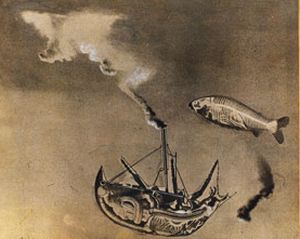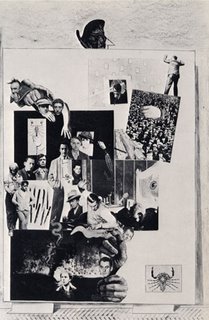DADAISM - Photomontage - Max Ernst
The DADA cultural movement began in Switzerland during the time of the First World War. The ethos was to challenge convention and aesthetics and oppose intellectual oppressiveness of any kind. It was often concerned with political statements and influenced other art movements including surrealism, Pop Art and Fluxus.
Max Ernst – often thought to be the inventor of FROTTAGE, created surrealist works in the 1920’s as part of the German Dadaist movement; a commentary on World War I and not so much ‘anti-establishment’ as those in Zurich. The German Dadaist dealt in overt manifesto and propaganda. In fact the term and technique of Photomontage was created by the Berlin Dadaists i.e. introducing photography into their works. Montage in German means ‘assembly line’ and Monteur means engineer; the artists thought of themselves as engineers and rejected the idea of being an ‘artist’ as a bourgeois pursuit of self importance.

The juxtaposition of the human and the mechanical was a recurrent theme in Ernst and Berlin Dadaists. Fragments of text are used in photomontage a lot more aggressively than in Cubism, a clear and obvious distinction between word and image.
In an essay by John Berger ‘The Political Uses of Photomontage’: “The peculiar advantage of photomontage lies in the fact that everything which has been cut out keeps its familiar photographic appearance. We are still looking first at things and only afterwards at symbols”.

Max Ernst – often thought to be the inventor of FROTTAGE, created surrealist works in the 1920’s as part of the German Dadaist movement; a commentary on World War I and not so much ‘anti-establishment’ as those in Zurich. The German Dadaist dealt in overt manifesto and propaganda. In fact the term and technique of Photomontage was created by the Berlin Dadaists i.e. introducing photography into their works. Montage in German means ‘assembly line’ and Monteur means engineer; the artists thought of themselves as engineers and rejected the idea of being an ‘artist’ as a bourgeois pursuit of self importance.

The juxtaposition of the human and the mechanical was a recurrent theme in Ernst and Berlin Dadaists. Fragments of text are used in photomontage a lot more aggressively than in Cubism, a clear and obvious distinction between word and image.
In an essay by John Berger ‘The Political Uses of Photomontage’: “The peculiar advantage of photomontage lies in the fact that everything which has been cut out keeps its familiar photographic appearance. We are still looking first at things and only afterwards at symbols”.


0 Comments:
Post a Comment
<< Home